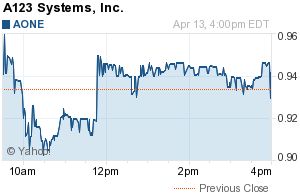A123 (Nasdaq: AONE) is having a string of bad luck in 2012.
In the face of recent genuinely positive design wins for the lithium-ion battery maker across its target markets of transportation and utility-scale storage, the firm is facing threatening self-induced -- as well as external -- issues.
A battery manufactured by A123 exploded and caused an injury at a General Motors battery lab. The battery leaked gases into a lab at GM’s Warren Technical Center in Michigan and an explosion ensued that sent one employee to the hospital with chemical burns, according to the Wall Street Journal. A123 is also receiving its share of class action lawsuits.
Other painful news from A123, prior to the explosion, was the just-announced "field campaign to replace battery modules and packs that may contain defective prismatic cells produced at A123's Livonia, Mich. manufacturing facility," according to a release. The "defect has been discovered only in some prismatic cells" built at the firm's Livonia facility. Up to five customers, including Fisker, might have received faulty cells.
The A123 replacement "campaign" will have a price tag of $55 million, spread out over several quarters. That's one-quarter of the revenue projected for 2012, which A123 recently guided as falling in the range of $230 million to $300 million. Since A123 will continue to operate at a loss, it will have to raise significant capital to cover its losses, the recall, and a recently announced shareholder suit. The firm has not revealed how it will raise that money.
About a year ago, VC investor Vinod Khosla spoke to about 300 energy storage experts at the annual Energy Storage Association (ESA) meeting and predicted that A123 would not be around in ten years. He cited lithium's volatility and inherent safety issues. That news was less satisfying for the audience (which included A123).
The stock market is showing its displeasure with the lithium-ion battery maker, sending its shares to record low prices. The company's stock is at 94 cents per share, and has shed more than 90 percent of its value since its 2009 IPO price of $13.50. The company has a market value of $138 million.

As Jeff St. John has reported:
A123 Systems may be struggling with the automotive battery business, but it’s making some strides on grid energy storage, announcing several projects in December that show how large-scale lithium-ion batteries can help the power grid. A123 announced an 11-megawatt energy storage project to back up a wind farm that Sempra Energy plans to build on the Hawaiian island of Maui. A123 is also supplying 32 megawatts to AES Energy Storage to provide frequency regulation and wind power smoothing in West Virginia.
As of July, the Waltham, Mass.-based company had grid battery installations and orders that added up to 100 megawatts by the end of 2011, much of it in partnership with AES Energy Storage.
Another project with Massachusetts utility NSTAR is a 2-megawatt pilot that A123 will own and operate to serve ISO New England’s frequency regulation market under the grid operators Alternative Technology Regulation (ATR) pilot program.
A123’s project with Hawaii’s Maui Electric Co. is aimed at supplying a different set of energy storage functions. The battery array will be installed at a substation serving the high-end resort community of Wailea, and will be able to supply 1 megawatt-hour of energy storage, both to reduce peak load by as much as 15 percent and to smooth voltage and improve power quality, said Chris Reynolds, Maui Electric’s operations superintendent.
Grid energy storage is still cost-prohibitive in all but a handful of edge cases, but it’s also expected to be increasingly important as intermittent wind and solar power take a larger role in power generation.
Of course, in order for A123 to continue to win and deliver to these utility-scale and automotive contracts, the struggling firm must raise the cash it needs to pay for its recall, losses, and lawsuits.



